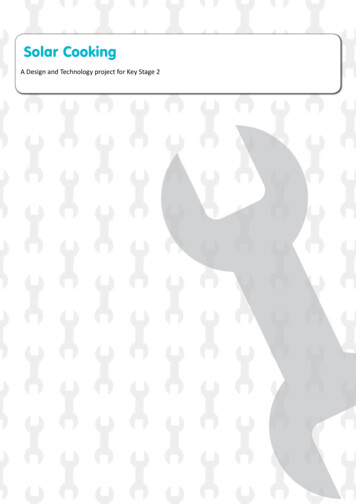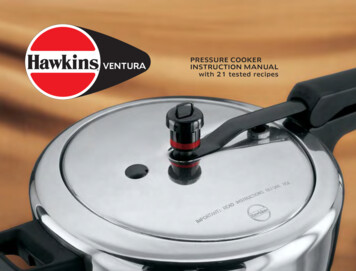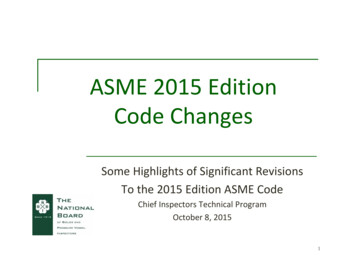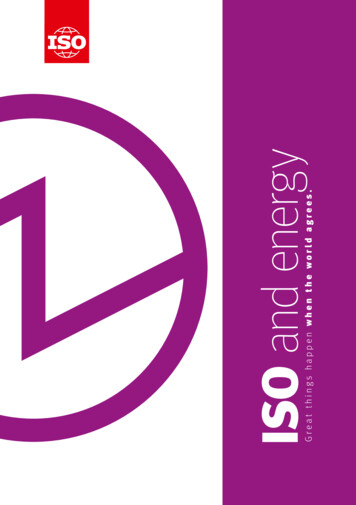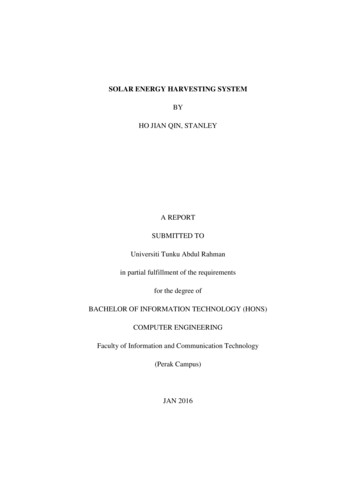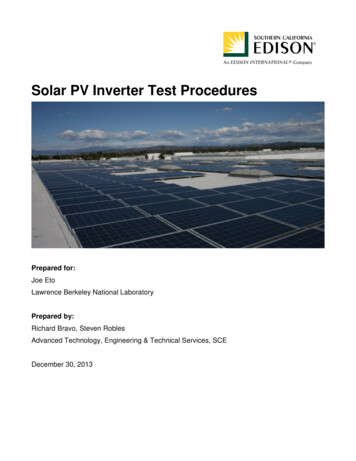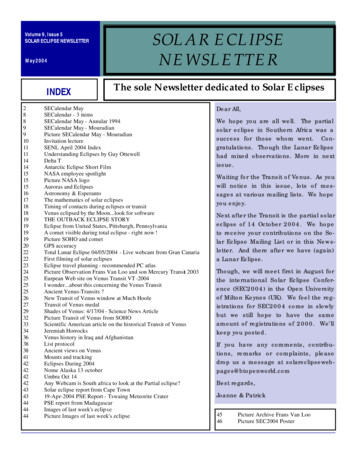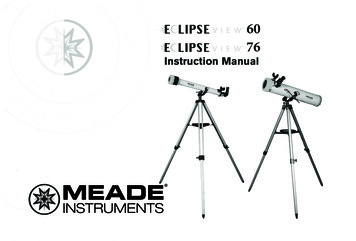
Transcription
,ekamotwHo d enjoynaesunioth dit10 eSolar Cookers Internationalspreading solar cooking to benefitpeople and environments
SOLAR COOKERS How to make, use and enjoy10th Edition, 2004This guidebook is a sum of contributions from educators, engineers, long-timesolar cooks and promoters, most of who served as volunteers with Solar CookersInternational (SCI). Special thanks to Mark Aalfs, Paul Barth, Elinor Benes,Roger Bernard, Rick Blodgett, Barbara Blum, Bev Blum, Georgianna Borgens, JayCampbell, Don Coan, Sherry Cole, Ramón Coyle, Maria Gonzalez, Gerri de Graaf,Tom Juring, Barbara Kerr, Barbara Knudson, Beth Luna, Dave Maize, Paul Mellersh,Bob Metcalf, John Murphy, Faustine Odaba, Joe On, Margaret Owino, Ed Pejack,Kevin Porter, Mark Rothman, Louise Seeley, Clark and Eleanor Shimeall, RandySmith and Kim Victorine. This edition received support from the Richard and RhodaGoldman Fund and the Sacramento Area Earth Day Network. Past editions of thisbooklet were supported by the American Conservation Association, the EducationalFoundation and the W. Alton Jones Foundation.Solar Cookers International is a 501(c)(3) nonprofit, nongovernmental organizationspreading solar cooking to benefit people and environments.Solar Cookers International1919 21st Street, Suite 101Sacramento, California 95811-6827United States of AmericaTel: 1 (916) 455-4499Fax: 1 (916) 455-4498info@solarcookers.orgsolarcookers.org solarcooking.org
CONTENTSIntroductionWhy solar cook?Is solar cooking for you?34Solar cooker conceptsTypes of solar cookersHow solar cookers workFrequently asked questions678How to make and use solar cookersModel 1: Panel cooker (the CooKit)Model 2: Box cookerSubstitute materials121826Solar recipes and tipsGrains, PastaLegumesMeatsVegetablesFruitBreads, Baked goodsOther foodsQuick treats3132333435363738Alternative solar cooker usesSolar pasteurizationOther uses4042Ideas for teachersQuickie demo CooKitSolar activities4445A brief history of solar cookingA brief history of solar cooking52
SECTION 1 INTRODUCTION
SOLAR COOKERS How to make, use and enjoyWhat exactly is a solar cooker? It isa device that allows you to cookfood using the sun’s energy as fuel. Isit really possible to cook with the sun?Yes, and this booklet will show you how.It will walk you through the process ofbuilding a simple solar cooker, usingthe cooker, and teaching simple solarcooking concepts to others.From the beginning of time — and stillfor many today — daily cooking hasrequired fire, fuel gathering and frequentattention to be sure foods cook evenly,don’t burn and don’t stick to the pot.Depending on where you live and howyou cook, solar cooking can save youtime, work and fuel. And it’s environmentally benign. All foods can be cooked insome type of solar cooker. This booklet covers low- to medium-temperature solarbox cookers and solar panel cookers (“CooKits”) that slowly and gently cook all thefoods you boil, roast or bake. Other types of solar cookers reach high temperaturescapable of frying.Slow cooking is different, but the differences are nice. Slow cooking retains flavor,moisture and nutrients, and makes meats tender. Recent studies indicate that foodscooked at moderate temperatures may be healthier.When solar cooking, add approximately one hour to normalcook times. No need to watch, stir or worry about food. Thecook spends just two minutes: one to put food in and one totake food out. For many of us, solar cooking has become ourfavorite way to cook.Solar cookers complement traditional cooking methods, whichare still used at night and during inclement weather.This booklet includes solar cooking concepts, solar cookerconstruction plans and directions for use, recipes, studentactivities and examples of non-cooking uses of solar cookersincluding solar water pasteurization — a basic survival skill.Solar cooking can make a world of difference if we each use it on sunny days andshare this information with others. SCI depends on the support of its members anddonors to continue to bring this life-saving knowledge to millions of families in fuelscarce, sun-rich parts of the world. We invite you to join us in this effort.Bon appétit!
SOLAR COOKERS INTERNATIONAL Sunshine is free. Solar cooking saves precious fuel forevenings, cloudy days and cold weather. Foods cook unattended while you do other things. Pots are easy to clean. Food doesn’t stick on the insideand there’s no soot on the outside. A solar cooker is easy to make from a variety ofmaterials.Solar cookers are safe, healthy and convenientWHY SOLAR COOK?Solar cookers save money and time There is no fire to cause burns or blow out of control. There is no smoke to injure eyes and cause lung problems. People allergic tosmoke can now enjoy “solarcues” — barbecues without the smoke. Most solar cookers cook at 82-121ºC (180-250ºF), ideal for retaining nutrients,moisture and flavor and not burning foods. Wood and gas fire temperatures,by contrast, exceed 260ºC (500ºF). You can bake, boil and lightly fry foods in their own juices. Meats get verytender. Solar water pasteurization is a skill everyone should know for emergencies. When solar cooking, your kitchen stays cool on hot, sunny days. A CooKit folds for easy storage or carrying for meals away from home.Solar cookers are versatile and adaptable The simple technology is easily adapted to a wide variety of constructionmaterials, cooking customs and climates.Solar cookers are life-saving devices for those in sunny, fuel-scarce regions Solar cookers help two of the world’spressing problems — growing shortagesof cooking fuels and the scourge ofwaterborne diseases. Half the world’spopulation cooks over wood fires.According to the United Nations, aboutone-third of us — two billion people —now suffer fuel wood shortages. Women,and sometimes children, must carry fuelfurther distances, and spend more timedoing so, than in the past. Some urbanfamilies spend 30-50% of their income on
SOLAR COOKERS How to make, use and enjoycooking fuel or must barter away food for fuel to cook the remainder. Familiesdrop the nutritious foods that require lengthy cooking — such as legumes— from their diet, contributing to malnutrition. Many governments importand subsidize fossil fuels. With solar cookers families often reduce fuel woodneeds by half. Pasteurizing water and milk in solar cookers can help reduce Cholera andother waterborne diseases, which kill 50,000 people every day. The WorldHealth Organization estimates 80% of all illnesses are spread throughcontaminated water.Solar cookers save trees and soilIn deforested areas, efforts to protect scarce trees fail when people haveno alternatives to wood-fueled cooking. As a government administrator inZimbabwe said, “When trees are gone, then follows erosion of the soil. . Thefarmer is unable to use the land. . The soil is washed into the river. Waterneeded for irrigation is no longer there. Then cotton and wheat are moreexpensive. . This is a circle without end.” Each solar cooker in sunny, arid climates can save one ton of wood per year.Solar cookers help air qualityIS SOLAR COOKING FOR YOU? Burning traditional fuels such as wood and gas pollutes the air and contributesto global warming. Solar cookers provide a pollution-free alternative. A checklist Do you have mostly-sunny days several months of the year? (Essential) Do you have a space outside that is sunny for several hours, sheltered fromhigh wind and safe from theft or tampering? Are your cooking fuels expensive or scarce? Does your kitchen sometimes get too hot or your barbecue too smoky? Do you worry about safety of small children near your kitchen stove or opencooking fire? Do you want to prepare for emergencies or camping when you may not havesafe drinking water? Would you like carefree, absentee cooking?If you checked several boxes, you’ll probably like solar cooking!
SECTION 2 SOLAR COOKER CONCEPTS
TYPES OF SOLAR COOKERSSOLAR COOKERS How to make, use and enjoyThere are many types of solar cookers — heat-trap boxes, curved concentrators andcombinations of both.Box cookersBox cookers are the most widely used in households.There are several hundred thousand in India alone.Curved concentrator cookersCurved concentrators (often called parabolic cookers)cook fast at very high temperatures like fire, but requiremore frequent adjustment and supervision for safeoperation. They are not covered in this booklet, butseveral hundred thousand households in western Chinause them. They are especially useful for large-scaleinstitutional cooking.Combination cookersCombination cookers (often called panel cookers)incorporate elements of box and curved concentratorcookers. SCI’s simple “CooKit” is the most widely usedcombination cooker.Compared to curved concentrator cookers: it doesn’t need to be moved to track the sunduring several hours of unattended cooking temperatures are more even the flat shiny surfaces are safer for your eyesCompared to a box cooker: it requires no window or insulation it cooks just one pot at a time, but several units cost less than one box cookerCompared to both: it is easier and cheaper to produce it folds compactly to carry and store it requires 10-20 clear, heat-resistant plastic cooking bags per year
SOLAR COOKERS INTERNATIONALSunlight is the fuel. A solar cooker needs an outdoor spot that is sunnyfor several hours and protected from strong wind, and where food willbe safe. Solar cookers don’t work at night or on cloudy days.Convert sunlight to heat energyDark surfaces get very hot in sunlight, whereas light surfaces don’t. Food cooksbest in dark, shallow, thin metal pots with dark, tight-fitting lids to hold in heat andmoisture.HOW SOLAR COOKERS WORKFuel: sunlightRetain heatA transparent heat trap around the dark pot lets in sunlight, but keeps in the heat.This is a clear, heat-resistant plastic bag or large inverted glass bowl (panel cookers)or an insulated box with a glass or plastic window (box cookers).Capture extra sunlightOne or more shiny surfaces reflect extra sunlight onto the pot, increasing its heatpotential.
FREQUENTLY ASKED QUESTIONSSOLAR COOKERS How to make, use and enjoyWhat can I cook?Use your solar cooker to cook vegetables, fruits, meats, grains, legumes and mostother foods. You can even bake breads and desserts! Simple solar cookers cannotstir-fry or cook flat breads that require high temperatures.Do I need to add water to foods that will be solar cooked?Vegetables, fruits and meats cook great without water, which tends to slow cookingand wash away nutrients. For grains and legumes, use the amount of water youuse with other cooking methods. If the food comes out too moist or dry, adjust theamount of water next time.What time of year can I cook?In general, you canuse your cookerwhen the length ofyour shadow on theground is shorterthan your height.Faster cookingSlower cookingNo cookingThis is an indicatorthat the sun is high enough in the sky to cook. In many countries there are a fewmonths each year when simple solar cookers cannot be used. People living in thedarker areas on the following map tend to have longer cooking seasons.What time of day can I cook?You can typically cook two meals per day — a noontime meal and an eveningmeal. You cannot cook early in the morning or after sunset. The sun is most intensebetween 10:00 a.m. and 2:00 p.m., which is when breads, cakes and pastriesshould be baked if possible.
SOLAR COOKERS INTERNATIONALHow long do foods take to cook?There are many factors that affect the speed with which your food cooks in a solarcooker, including time of year, amount of sun, type of pot and amount of food. Thefollowing table summarizes some important factors.Faster cookingSlower cookingTime of year and day:Amount of sun:Amount of wind:Thickness of pot:Amount and size of food:Amount of water:
SOLAR COOKERS How to make, use and enjoy275 F135 C212 FSimple Solar Cookers100 C Water boils180 F160 F150 F82 C71 C65 CFood CooksFood pasteurizationWater pasteurization120 F49 CMost germscan't grow72 F22 CRoom temperatureSimple solar cookers, under normalconditions, will cook at temperatures from82-121 C (180-250 F) or more. Sincefood cooks at 82-91ºC (180-195ºF) thesetemperatures are hot enough to fully cookfood, but not so hot as to burn or dry outfood or damage healthful nutrients. Also,many foods can cook for several hourswithout overcooking, which allows food tobe placed in the cooker early in the day andleft until mealtime without needing to bestirred or monitored. (“Absentee cooking.”)As with any cooking method, cooked foodthat is allowed to cool to temperaturesbetween 52-10ºC (125-50ºF) for a period oftime may contain bacteria that can spoil food and lead to food poisoning. Food that staysin this temperature range for more than four hours should be discarded.Here are some typical cooking times for 4 pounds (2 kilograms) of food on a sunny day:1-2 hours103-4 hours5-8 hours
SECTION 3 HOW TO MAKE AND USE SOLAR COOKERS
MODEL 1: PANEL COOKER (COOKIT)SOLAR COOKERS How to make, use and enjoyThe CooKit is a simple, portable solar cooker. It can be made in one to two hoursand can cook one large pot of food for about six people. For larger families, make alarger CooKit or several this size.Construction materials Corrugated cardboard (carton board) — 0.9x1.2 meters (3x4 feet) Aluminum foil — 0.3x3 meters (1x10 feet), cut into strips as needed Glue (nontoxic, water-based, diluted 1:1 with water) Paintbrush (the foam type work well) Utility knife or similar cutting device Pencil, pen or other marking device Large ruler or other straight edge See page 26 for substitute materialsConstruction steps1. Draw cut and fold lines on cardboard as indicated below.CUT LINESFOLD LINES(optional fold lines for compact storage)12"/30cm12"/38"/20cm10"/25cm90 m/20c8"11"/28narrow slot, width ofcardboard thickness(about ⅛"/0.3cm)11"/28cmcm12"/30cm73 12"/30cm12"/30cmm8"/20cm11"/28cm5"/13c61 24"/61cm1236"/91cm8"/20cm13"/399 48"/122cm36"/91cm98 3cm13"/33cm0cm
SOLAR COOKERS INTERNATIONAL2. Cut out the CooKit shape and slots.Cut out the CooKit shape and the two 60º angled slots in the front panel. Be sureto make the slots narrow so the 73º angled corners from the back panel fit snuglyto hold up the front panel. (Refer to step 3, page 14.)3. Score the fold lines.With a blunt edge, such as a spoon handle, score the fold lines. Make straightfolds by folding against a firm straight edge. Only score the optional fold lines ifyou intend to fold the CooKit for compact storage. (See page 17.)4. Glue foil on CooKit.Using a paintbrush, spread theglue/water mixture on the dullside of aluminum foil and pressthe glued sheets of aluminumfoil tightly and smoothly likewallpaper onto one entire sideof the CooKit. A few wrinkleswon’t hurt.5. Leave flat until dry. Trim any excess foil.Cooking directions1. Put food in a dark pot with a dark, tight-fitting lid.2. Enclose pot in a transparent heat trap.Put the pot in a clear, heat-resistant plastic bag and bind the open end of the bagor simply fold it under the pot in such a way as to prevent air from escaping. Thebag should be loose enough that a small, insulating layer of air exists around thepot.13
SOLAR COOKERS How to make, use and enjoyOptional: Cooking efficiency may bemarginally improved by placing the poton a pot “stand” — three or four stones,a couple of twigs, a small wire rack, etc.— located inside the bag. This helpscreate a thin layer of air under the pot,reducing heat loss to the cooker itself. Foroptimal performance, Dr. Steven Jones ofBrigham Young University recommends raising the pot 6 centimeters with anopen-mesh wire stand located inside the bag (see image below). This allowssunlight to be reflected underneath the pot as well as on the sides and top. Forbest pot stability make the wire stand slightly wider than the pot, and slightlytaller than 6 centimeters, so that the pot can rest inside the stand on twocrossed wires at the 6 centimeters height. Again, these steps are optional.3. Assemble the CooKit.In a shaded area, lay the CooKit shiny side up sothat the wide (back) panel is away from you. Tiltthe back panel towards you and carefully slidethe ends of its flaps into the slots on the shorterfront panel that is nearest to you. (As you dothis you will need to also tilt the front panel up.)Clamp the inserted flaps, on the underside of thefront panel, using clothespins or similar device.14
SOLAR COOKERS INTERNATIONAL4. Choose a cooking location.Set the cooker on a dry, level surface in direct sunshine away from potentialshadows. For best results, solar cooking requires continuous, direct sunshinethroughout the cooking period.5. Orient the CooKit.Orient the CooKit according to the details below. Once oriented, the CooKitdoesn’t need to be moved again during three to four hours of cooking. For longercooking, or for large quantities of food, reorienting the cooker every couple ofhours speeds cooking a little. Food cooks fastest when the shadow created by thecooker is directly behind it. TO COOK A NOONTIME MEAL orient the cooker so that the shorter, frontpanel faces easterly, or approximately where the sun will be mid-morning.In general, it is good to get the food out early and not to worry about it untilmealtime. For most dishes you should start cooking by 9:00 or 10:00 a.m. TO COOK AN EVENING MEAL orient the cooker so that the shorter, frontpanel faces westerly, or approximately where the sun will be mid-afternoon.For most dishes, it is best to start cooking by 1:00 or 2:00 p.m. FOR ALL-DAY COOKING orient cooker where sun will be at noon or earlyafternoon and food will be ready and waiting for the evening meal.6. Adjust front flap.Raise or lower the front flapso there is a small shadow,no more than half its width,under it. The flap should beangled higher when the sun ishigh and lower when the sunis low. You want the front flapto reflect the sun, not block it.ShadowShadow15
SOLAR COOKERS How to make, use and enjoy7. Set the bag-enclosed pot on the flat part of the CooKit.Optional: on windy days, large stones or bricks can beplaced on each side of the flat part of the CooKit thatextends beyond the side reflective panels, as well as underthe front panel.8. Leave food to cook for several hoursor until done.There is no need to stir food while itis cooking.9. Remove the pot.Using pot holders, remove the potfrom the CooKit. (Pots get VERY hot.)To prevent steam burns, open thebag away from you when removingthe pot, and slide pot lid toward youwhen opening pot.Enjoy a delicious meal!For less glare from the reflectorwhen putting in or taking outfood, stand or squat in front of theCooKit with your back to the sunto make a shadow. Many solarcooks also wear sunglasses.16
SOLAR COOKERS INTERNATIONALCare and storageStore the CooKit in a safe place away from moistureand animals, preferably indoors. Periodically wipereflective surfaces gently with a dry cloth. If thecardboard (carton board) accidentally gets wet, lay itflat — shiny side down — until dry.Allow plastic bags to air-dry or gently wipe drywith a towel. Heat-resistant bags, handled properly,should last 10 or more uses. Bags gradually become brittle from exposure tosunlight and heat, and will eventually develop small tears. Tape can be applied tothe outside of small tears to temporarily extend bag usefulness.The CooKit is designed to be compact and portable.When not in use it can be simply folded lengthwise intothirds or, if needed, folded flat to about 33 centimeters(13 inches) square.Fold to backFold to front17
MODEL 2: BOX COOKERSOLAR COOKERS How to make, use and enjoyThis box cooker takes one to two days to make, plus overnight drying. It cooks two tothree pots of food. If rocks or bricks are heated alongside the pots, the box cooker willmaintain heat for a couple of hours after sunset with the lid closed.Construction materialsGlass Two large, shallow corrugatedcardboard (carton board) boxes,nestable as follows:An INNER BOX at least 45x55centimeters (18x22 inches),preferably just a little bit tallerthan your pots.Metal sheetInner boxAn OUTER BOX a little larger inall dimensions so there is at least3-5 centimeters (1-2 inches)space between the two boxesOuter boxon all sides when nested. Idealproportions: one unit tall bytwo units long (front to back) bythree units wide (side to side).Cookers that are too tall createshadows across the pot andincrease heat loss through walls.Lid piece Corrugated cardboard (cartonboard) at least 15 centimeters (6inches) longer and wider than the outer box to make the lid Window glass at least 50x60 centimeters (20x24 inches) and longer and widerthan the inner box Thin, black metal sheet, sized equal to or slightly smaller than the inner box Aluminum foil — 0.3x20 meters (1x60 feet), cut into strips as needed Dry plant fibers or about 50 sheets of newspaper, quartered and looselycrumpled Glue (nontoxic, water-based) Silicone caulk Rigid wire (hanger wire, etc.), or a stick and string — 0.7 meters (2 feet) each Paintbrush (the foam type work well) Utility knife or similar cutting device Pencil, pen or other marking device Large ruler or other straight edge See page 26 for substitute materials18
SOLAR COOKERS INTERNATIONALConstruction steps1. Cut window opening in outer box.Turn outer box upside-down. Onits bottom, center the inner box anddraw a line around it.Cut out this piece to make a windowopening the same size as the innerbox. There should be a small rim onall four sides 5-7 centimeters (2-3inches) wide.2. On lid piece, make fold lines and cutwindow opening/reflector flap.Center the outer box on the lid pieceand trace around it (these are foldlines). Extend these lines out to theedges of the lid piece.Center the inner box between the foldlines on the lid (that you just drew)and trace around this box as well.Cut only three sides of the inner line— two short sides and one long one.Fold up the resulting flap for thereflector, creating a window frameopening the same size as the innerbox.19
SOLAR COOKERS How to make, use and enjoy3. Adjust height of boxes, if needed.Set a cooking pot next to both boxes.The inner box needs to be just a littletaller than your pots. The outer boxneeds to be just a little taller than theinner box.If the boxes are too tall:ON THE INNER BOX make amark about 3 centimeters (1 inch)above the top of the pot and drawa fold line straight around the fourbox walls. Score the fold lineswith a blunt edge such as a spoonhandle.ON THE OUTER BOX makea mark about 5 centimeters (2inches) above the top of the potand draw a fold line straightaround the four box walls. Scorethe fold lines with a blunt edgesuch as a spoon handle.Cut the corners of both boxesdown to the fold lines.Fold sides outwards along thecreases.4. Trim inner box flaps.When the walls of the inner box arefolded down to the right height — orif you didn’t have to adjust yourbox height — trim off at about 5-7centimeters (2-3 inches) above thefolded crease to make flaps as narrowas the small rim around the windowopening on the outer box. (Refer tostep 1, page 19.)20
SOLAR COOKERS INTERNATIONAL5. Join boxes.Turn the outer box right-side up, sothe window opening and rim aredown. Spread glue on the inside ofthe rim.Turn the inner box upside down andlower it into the outer box, onto theglue. Press the small flaps against theinside of the rim around the windowopening to join the two boxes intoone double-walled box, now open atthe bottom (which should be facingup at this point).6. Insulate and seal.Without disturbing the drying glue,carefully spot-glue aluminum foilon both walls and the underside ofthe inner box, covering all surfacesbetween the two boxes. This layer offoil helps to insulate the cooker.Lightly fill the gaps between the twoboxes with crumpled newspaper,plant fiber or other insulation.Add a few strips of cardboard andmore crumpled newspaper or otherinsulation on the underside of theinner box (which should be facing upat this point).Close and glue the flaps of the outerbox to seal the bottom of the cooker.21
SOLAR COOKERS How to make, use and enjoy7. Glue foil inside the box and lid.Turn box right-side up.Dilute glue 1:1 with water and, usinga paintbrush, spread it thinly on thedull side of sheets of aluminum foil.Press the glued sheets of aluminumfoil tightly and smoothly likewallpaper to the inside and rim of thebox. A few wrinkles won’t hurt. Setaside to dry.Repeating the procedure, glue foilto the underside of the lid flap (thefolded up center part only).8. Cut, fold and glue the corners of thenew lid.With the lid upside down (foil facingup), make one cut at each of the fourlid corners, just to the first fold lines.(Cuts should be parallel to the longside of the lid.) Score all fold lineswith a blunt edge such as a spoonhandle and fold along creases with astraight edge.Overlap and glue the corners, andhold with clothes pins or clampsuntil the glue is dry. To make quickclamps, cut cardboard-width slits in asmall stack of cardboard pieces.9. Insert the window.Spread silicone caulk along theunderside edge of the windowopening rim (outside the cut edge ofthe foiled reflector piece), then pressthe glass in firmly but carefully tomake a good seal with the caulk.Let box and lid dry overnight.22
SOLAR COOKERS INTERNATIONAL10. Make an adjustable prop.Make small holes in a corner of thelid reflector and side of lid as shown.Loop string through the holes.Make several notches in a stick, andtie the stick at both ends to holdup the reflector and allow angleadjustments. or Bend a sturdy wire at both ends andglue corrugated cardboard (cartonboard) strips to the lid and reflectoras shown. The wire can be insertedinto any of the corrugations for angleadjustments.11. Add the black tray and “cook” thecooker.Put the black metal sheet inside thebox. (The pots will sit on this lightabsorbing sheet.) Put on the lid, withthe lid reflector propped open, andaim toward the sun for several hoursto drive out the last bit of moistureand any paint or glue fumes.23
SOLAR COOKERS How to make, use and enjoyCooking directions1. Put food in dark pot(s) with dark, tight-fitting lid(s).2. Choose a cooking location.Set the cooker on a dry, level surface in direct sunshine away from potentialshadows. For best results, solar cooking requires continuous, direct sunshinethroughout the cooking period.3. Put pot(s) in cooker and replace lid.Put pot(s) in cooker. If cooking multiple dishes,quicker cooking items should be placed towards thefront of the cooker (opposite the reflector) and slowercooking items towards the back, where access tosunlight is best. Place lid on cooker.4. Orient the cooker.Orient the cooker according to the details below. Once oriented, the cookerdoesn’t need to be moved again during three to four hours of cooking. For longercooking, or for large quantities of food, reorienting the cooker every couple ofhours speeds cooking a little. Food cooks fastest when the shadow created by thecooker is directly behind it.24
SOLAR COOKERS INTERNATIONAL TO COOK A NOONTIME MEAL orient the cooker so that the front side(opposite the reflector) faces easterly, or approximately where the sun will bemid-morning. In general, it is good to get the food out early and not to worryabout it until mealtime. For most dishes you should start cooking by 9:00 or10:00 a.m. TO COOK AN EVENING MEAL orient the cooker so that the front side(opposite the reflector) faces westerly, or approximately where the sun will bemid-afternoon. For most dishes, it is best to start cooking by 1:00 or 2:00 p.m. FOR ALL-DAY COOKING orient cooker where sun will be at noon or earlyafternoon and food will be ready and waiting for the evening meal.5. Adjust reflector.With the adjustable prop, angle the reflector so that maximum sunlight shines onthe pots.Incorrect angleCorrect angleIncorrect angle6. Leave food to cook for several hours or until done.There is no need to stir food while it is cooking.7. Remove the pot(s).Using pot holders, remove the pot(s) from the cooker. (Pots get VERY hot.) If youwon’t be eating for a couple of hours, you may want to leave the pots in thecooker and close the lid. The insulative properties of the cooker will keep thefood warm for a while.Enjoy a delicious meal!Care and storageStore the cooker in a safe place away from moisture and animals, preferablyindoors. Periodically wipe reflective surfaces gently with a dry cloth.25
SUBSTITUTE MATERIALSSOLAR COOKERS How to make, use and enjoyCooker forms (bodies)Panel and box cookers are easily and inexpensively built using corrugatedcardboard (carton board) as the form. To increase durability, outer, non-reflectivesurfaces can be painted, oiled or waxed to help protect from moisture.FORMS FOR PANEL COOKERS should be rigid and durable. A number of materialswill work, including: Plain or corrugated plastics Wood Woven matsFORMS FOR BOX COOKERS (OUTER BOX) should be made of materials that holdinsulation and seal well with the lid. A number of materials will work, including: Plain or corrugated plastics Wood Metal Masonite Bricks or adobe Papier-mâchéFORMS FOR BOX COOKERS (INNER BOX) must withstand high temperatureswithout releasing fumes. The surface that faces the cooking pot should be reflective,lined with reflective material, or black. A number of materials will work, including: Wood Sheet metal Masonite Woven baskets or mats DON’T USE Styrofoam, vinyl plastics, bricks or adobeGluesWater-based polyvinyl acetate glues — such as Elmer’s Glue-All — can be diluted1:1 with water. Wheat or rice flower paste, acacia gum, and casein glue are otheroptions. Avoid petroleum- and rubber-based glues. Some cooker materials can besewn or stapled. Don’t use tape for inner cooker surfaces.Dark cooking potsFood is solar cooked in lidded, dark-colored pots or simila
Slow cooking is different, but the differences are nice. Slow cooking retains flavor, moisture and nutrients, and makes meats tender. Recent studies indicate that foods cooked at moderate temperatures may be healthier. When solar cooking, add approximately one hour to normal co
